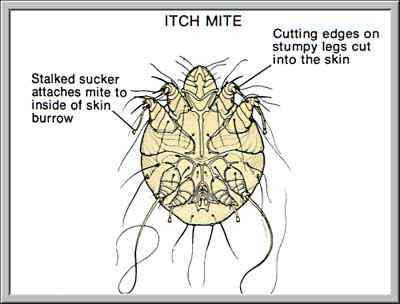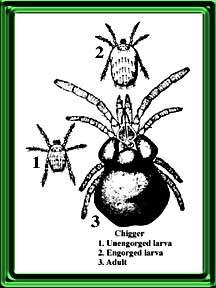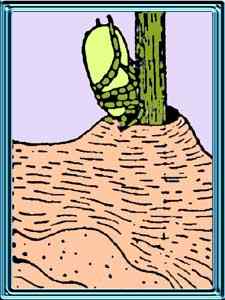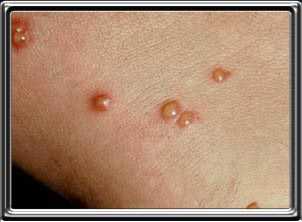OKaaaaaay...! we're on the last lap now, at least as far I intend to go with parasites at present, and we are going to talk about MITES...click on the links below if you don't want to read the basic information first.
These chappies belong to the Group Arachnid...yep..! they're spiders...ish. They in fact belong to the Order Acarina as also do ticks. In Europe it is only the itch mite which can be regarded as an important parasite of man, but other mites may occasionally cause trouble. In particular the Harvest mite (Trombicula autumnalis) often bites people in late summer. Mite larva have six legs and moult three or four times before the adult stage is reached. Some mites suck blood, while others are responsible for hypersensitive reactions. We are going to have a brief look at three varieties starting with the itch mite..
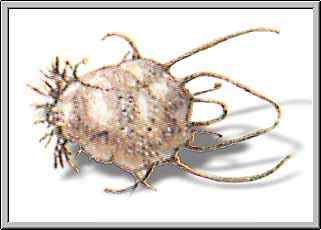
(The Itch Mite)
This mite is very seldom seen, lives actually in and on the skin, with the female burrowing tunnels in the upper horny layer, particularly on the front of the wrists, the sides and webs of the fingers, the buttocks, the genitals and the feet. Different varieties of Sarcoptes scabiei (De Geer) are believed to be specific for different mammals, including man and a large variety of domestic and wild animals, but are transferable from one host to another. The variety specific to man is generally referred to as the "itch" or "scab" mite, and acariasis caused by it is sometimes called "scabies." People are most likely to become infested when living in continually crowded quarters, such as slums or jails, or during periods of major calamities that result in prolonged overcrowding.They are so small that even the adults are barely visible to the unaided eye. Adult females are 0.33 to 0.45 mm long, and the males, 0.20 to 0.24 mm. The mites are a translucent, dirty-white color, with the more highly chitinized (shell or nail like composition) portions brownish. In living specimens, the body is seen to be divided into 2 regions by a fold in the integument (any natural protective covering, such as a skin, rind, or shell); the posterior portion bears the last 2 pairs of the 4 pairs of very short legs. The last 2 pairs of legs do not extend as far as the margins of the body.
Life Cycle: Both sexes and all stages of the itch mite tend to burrow into the skin immediately when placed on it, but the nymphs and males make only small, temporary holes, and move about frequently. The largest and longest burrows are made by the egg-laying female. The female always burrows in folds of the skin, preferring the deeper furrows and cracks. She can be induced to enter when a fine scratch has been made with a needle in the surface of the skin. She may also place herself in the acute angle between a sloping hair and the surface of the skin to gain support for initiating the burrowing (Heilesen, 1946). The winding burrow may reach a length of 5 to 15 mm.
It appears from the observations of various people that the adult life of the mite is from 2 to as many as 6 weeks. It is difficult to determine the number of eggs laid by a female in her lifetime, but it is usually estimated to be between 40 and 50. It has been observed that the period between the beginning of burrow formation and the finding of the first larva varied from 71 to 78 hours. The following are the numbers of days for the duration of the various life stages of the female: egg, 2.5 to 3.5; larva, 1.5 to 3; first nymph, 1.5 to 2.5; and second nymph, 2 to 4. He concluded that the life cycle required from 9 to 15 days. The numbers of days for the various life stages of the female, were as follows: egg, 3 to 4; larva, 3; first nymph, 3 to 4; second nymph, 3 to 4; and from copulation to oviposition, 2; a total of 14 to 17 days. The developmental period for the male was only 9 to 11 days. The parts of the body selected by the ovigerous female are the interdigital spaces; the wrists and the ulnar margins of the wrists; the elbows and the anterior folds of the axillae; the penis, scrotum, and buttocks; the back of the knee; and the ankles and toes. In young children, the egg burrows may occur on any part of the body, and in women, the undersides of the breasts are very commonly selected. These various findings are from Munro (1919) and Heilesen (1946).
Means of Transmission: The ease of transmission of body lice via infested clothing and bedding has led many people to assume that itch mites could be transmitted in the same way. An important difference, however, is that body lice live on their host's clothes and contact his body only to feed, whereas itch mites spend most of their lives beneath the host's skin. Merely putting clothing away for 2 or 3 days at ordinary room temperature should be sufficient to rid it of mites, as they dessicate very easily. Two persons in a bed gave the greatest opportunity for the spread of itch mites. However, transmission is also possible through dancing, flirtation, and ordinary intimate contact between members of a family.
Symptoms of Infestation: Whereas in animals large numbers of mites give rise to "sarcoptic mange," in humans relatively small numbers of mites can cause unpleasant symptoms, and the disease is known as "scabies." At a certain stage, the irritation may become so severe that the patient becomes frantic and suffers from lack of sleep. If the infestation is long continued, or if a later infestation occurs, an allergic reaction develops, with intense itching and a redness, or rash of follicular papules (small blister at the base of a hair) over much of the body. The rash may develop on areas such as around the armpits, the wrists, the waist, inside the thighs, and backs of the calves, but these areas do not necessarily coincide with those of mite infestation. The rash may occur over much of the body, even though only a few mites may be present in restricted locations between the fingers.
Medical Treatment: It is important to diagnose scabies correctly, for neither the irritation nor the liability to skin diseases can cease until the mites have been eliminated. Look for the burrow of a female in such places as between the knuckles and in folds of the wrist and elbow, and then gently prick the burrow open. Toward the end of the burrow, the mite can usually be distinguished as a dull-white spot. Remove it with a needle. A bath before treatment is desirable for hygienic reasons. Thorough treatment is essential, and is best done by a physician or a reliable nurse or orderly. Ramsay recommended that any preparations should be applied in the evening after the patient had taken a warm bath, and that the application be left in place until the next evening, when the treatment would be repeated. All areas of the skin below the neck should be treated, including body folds, palms, and soles. A cleansing bath should be taken 48 hours after the second application. Some tingling of the skin is to be expected after treatment, and it may last as long as 10 to 14 days. Calamine lotion or emulsion may be applied to alleviate this condition. Instructions on the package in which the medication is sold should always be read and followed carefully. Secondary infections may require the skills of a medical doctor or dermatologist. If the treatment is satisfactory and reinfestation occurs, an effort should be made to find untreated persons with whom the patient may have had contact.
Any treament described here is from my own research and should not be taken as policy. You need to see your own doctor if you have a problem.
Right..eo, let us look at those which cuddle up in bed with us..read a book....drink their Horlicks or Ovaltine....whatever they do..!
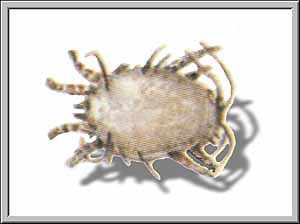
(Bed /Dust Mites)
Bed mites feed on the scales which are continually falling from our skin. The most common species of dust mite isolated in Britain is Dermatophagoides pteronyssinus from the family Pyroglyphidae, but there are other species of dust mite as well as predatory mites that share the same dusty environment. Dust mites live in the fine layer of minute dust particles that continually settles on household items. They are found almost world wide but their numbers are considerably reduced at high altitudes and dry climates. House dust mites have been known to be associated with allergies since the 1960's and have become a focus over the years for their involvement with respiratory ailments. They do not bite or sting but harbour strong allergens in their bodies as well as in their secretions, excreta and shed skins. Constant contact with these allergens can trigger respiratory and dermatological complaints in some humans.Dust mites favour homes with high humidity levels and constant warm temperatures, and under these conditions mite populations explode, although there are some seasonal fluctuations. The mites are known to concentrate in high traffic areas in homes and on certain furniture items, especially beds, upholstered lounges, chairs, and in carpets with long fibres. They are attracted to these areas for food, and they feed on shed human skin scales and secretions, house dust, fungal spores, pollen grains, plant fibres, and insect scales. Dust mites dislike strong light and will take harbourage in the seams, ledges, and framework of furniture when exposed. Due to their light weight, dust mites can become airborne during activities such as bed making, and in this way can be distributed throughout the room or house. They prefer a high humidity (c. 80%) and a temperature (c. 25C), and so are particularly common in beds. Recent researches in to the causes of asthma found that it is the dust containing them which causes the more intense attacks of asthma in sensitive patients. Apart from sprays it has been found that the best method to get rid of these mites is frequent and thorough vacuuming of the mattresses.
There is not one single clinical symptom that can readily identify mite-allergic asthmatic patients. This makes a clinical diagnosis difficult, and is therefore dependent on the reporting of other associated features. There is a proliferation of allergy clinics that specialise in testing for allergic responses to different materials including dust mites using skin prick tests. Medical conditions that are attributable to the presence of dust mites include allergic rhinitis, asthma, childhood eczema and other allergic conditions. Dust mites do not transmit any disease-causing pathogens.
Treatment and Control
Allergies from house dust mite can be managed by immunotherapy using mite extracts in conjunction with reducing the mite population in the home of the patient. It is virtually impossible to eliminate all dust mites from a household, but areas where mites tend to congregate can be targeted. Wall to wall carpet should be reduced, and replaced where possible with smooth hard surfaces that are easy to clean. Upholstered furniture can be avoided, mattresses and pillows should be encased in especially manufactured (‘plastic’) products that aid in the exclusion of mites. Bedding and curtains should be selected on their ability to withstand frequent laundering. Thorough vacuuming on a regular basis, including all mattresses, especially the seams and framework of the bed, will also help. A reduction in humidity levels by increased air circulation and ventilation throughout the house will assist in maintaining mites at a lower level.
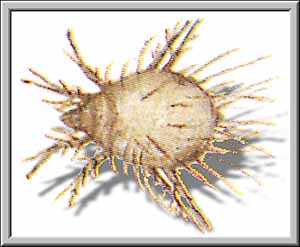
Glycyphagus
domesticus
(House Mite)
These small mites are very similar to those found in foodstuffs, but under a lens they can be recognised by the long hairs at their rear end. They may occasionally occur in foodstuffs, but they are primarily found in old fashioned upholstered furniture, which has been kept in a damp area for some time so that the stuffing has rotted. House mites then feed on the fungus, and multiply in large numbers. They occur particularly in upholstery stuffed with fibres derived from palm leaves. Nowadays these mites don't present a problem with modern furnishings and central heating, because like all other mites they quickly die if they become desiccated.
For problems caused in late summer, the Harvest Mite seems to be the biggest culprit. I hope the information that follows is of some use...
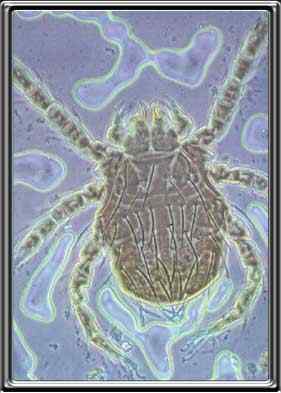
(Harvest Mite)
It is not the adult stage of the Harvest mite which causes the problems, but the six-legged larval stage which can send people and animals crazy scratching which then leads on to secondary infection. These are white to orange red in colour, that is before they have a good feed on you...and very small something like 1/100 of an inch, just about visible. To understand what is going on we need to know a bit of biology:Lifecycle:
Adult harvest mite overwinter near or slightly below the soil and in other protected places. Females become active in the spring and lay up to 15 eggs per day in vegetation when soil temperatures are 60°F. The larvae congregate in groups on small clods of earth, in matted vegetation and even on low bushes and plants, where they have more access to a prospective host. The first active stage in the life of the harvest mite is the six-legged larva and this is the only stage to attack warm-blooded animals. A drawing (courtesy of Ohio State University) shows the difference between the adult and the larvae.
The life cycle is about 50 to 70 days, with adult females living up to one year and producing offspring during this time. Multiple generations occur in warmer climates, whereas only two to three develop each season in some northern areas/countries. They are active only during the day and their movements appear to be controlled chiefly by the weather, aren't we all, they are most active when it is dry and sunny and least active when the day is cold and wet, as is the case with most insects. When the larvae come into contact with any warm-blooded animal (dogs are particularly susceptible), they swarm onto it and wander in search of a place to attach themselves. Infestation in human beings generally occurs by way of the ankles when walking in areas where the mite is common; sitting or lying on infested ground offers even better opportunities to the mite.
The thickness of the skin is probably the most important factor because the harvest mite feeds by thrusting its small hooked chelicerae (fangs) into the surface layers of the skin. Where the skin is unusually thick they attach with difficulty and may be brushed off by the movements of the host. Young harvest mite larvae attach themselves to the skin of people, domestic animals, wild animals (including reptiles), poultry and birds. The preferred feeding locations on people are parts of the body where clothing fits tightly over the skin such as around the belt line, waistline, under girdles and under socks, or where the flesh is thin, tender or wrinkled such as the ankles, in the armpits, back of the knees, in front of the elbow, or in the groin, especially around hair follicles (see below again courtesy of Ohio State).
The insertion of the small fangs into the skin is painless, and is merely intended to puncture the skin so that the feeding process can begin. Harvest mite larvae do not burrow into the skin, nor suck blood. They pierce the skin and inject into the host a salivary secretion containing powerful, digestive enzymes that break down skin cells that are ingested (tissues become liquefied and sucked up). Also, this digestive fluid causes surrounding tissues to harden, forming a straw-like feeding tube of hardened flesh (stylostome) from which further, partially-digested skin cells may be sucked out. After a larva is fully fed in four days, it drops from the host, leaving a red welt with a white, hard central area on the skin that itches severely and may later develop into dermatitis. Any welts, swelling, itching, or fever will usually develop three to six hours after exposure and may continue a week or longer. If nothing is done to relieve itching, symptoms may continue a week or more. Scratching a bite may break the skin, resulting in secondary infections. However, harvest mites are not known to transmit any disease in this country.
Once the larva has finished feeding it drops to the ground to complete its lifecycle. It descends into the soil and, after a period of five or six weeks, changes into an eight-legged nymph. This stage is sexually immature like the larva, but it resembles far more closely the adult male or female into which it eventually develops. Both the nymph and the adult live in the soil and feed on plant juices or small insects. They are never parasitic. They prefer moist conditions (as do all mites as otherwise they would desiccate) and are especially numerous in the vicinity of rabbit warrens. Thus the lifecycle of the harvest mite is completed. The eggs laid by the adult in the spring and summer hatch into the six-legged harvest mites which are most abundant in late summer and autumn. These, after they have fed on warm-blooded animals, develop through the nymph stage to the adult.
Distribution:
The harvest mite is widely distributed in the British Isles and is particularly abundant on chalk downs. The geological origin of the soil and the climate does not affect its abundance. Heavy infestations, however, are often found to be sharply localised; a heavy infestation may occur in the gardens of one or two houses in a village which is otherwise free from the pest. They may also be found in town gardens and parks.
Very common around blackberry bushes, woods, fields. Never sit on a freshly used brush hog! My butt was completely covered. I used a rag with bleach on it to scrub with. Killed them all instantly and never itched again! The last is from: bennettriverpup@peoplepc.com
Control Measures
Skin Care
After returning from a chigger/harvest mite-infested area, launder the field clothes in soapy, hot water (125°F.) for about half an hour (this applies to any insect infestation, washing clothes on cool wash does not work, so if your Amani jacket....well you know). Infested clothes should not be worn again until they are properly laundered and/or exposed to hot sunshine. Unlaundered clothes or those laundered in cool water will contain the biting chiggers to again reinfest your skin. As soon as possible, take a good hot bath or shower and soap repeatedly. The chiggers may be dislodged, but you will still have the stylostomes, causing the severe itch. Scratching deep to remove stylostomes can cause secondary infections. For temporary relief of itching, apply ointments of benzocaine, hydrocortisone, calamine lotion, or others recommended by your pharmacist or medical doctor. Some use Vaseline, cold cream, baby oil, or fingernail polish. (The sooner the treatment, the better the results.)
Prevention
Mowing of briars, weeds, and thick vegetation and close clipping of lawns, to eliminate shade and moisture, will reduce harvest mite larvae populations, and permit sunlight and air to circulate freely. Harvest mite larvae can penetrate many types of clothing, but high boots and trousers of tightly woven fabric tucked into stockings or boots help deter them.
Before going into an area where harvest mite larvae may be present, protect yourself by using a repellent or permethrin available at many chemists or hardware stores. Deet-based repellents are effective for only a few hours, whereas permethrin-based repellents are for use only on clothing and effective for several days. Apply the repellent to both the skin and clothing, especially on hands, arms, or legs, if uncovered, and to clothing openings at cuffs, neck, waistband, and upper edges of socks. Follow label directions since repellents may damage plastics, nail polish, and painted or varnished surfaces. Do not use indiscriminately as severe human allergies can develop. Keep moving since the worst harvest mite infestations occur when sitting or laying down in a sunny spot at midday with temperatures above 60°F. If possible, stick to roads and trails.
Insecticides
Treating known harvest mite larvae trouble spots is quicker and less expensive than treating an entire area. Place six-inch squares of black cardboard (black is a heat sink and will become warmer than the surrounding grass) on edge in the grass and observe for a few minutes (obviously on a dry day....!). Any small, yellowish or pinkish harvest mite larvae present will climb rapidly to the top of the square and congregate there. Make tests in 10 to 12 different spots such as grass, dead leaves, briars, weeds, etc. Unless the entire area is infested, treat only the spots where control is desired such as grass around picnic tables, lawn chairs, or recreational equipment (Always remember, when you are spraying insecticide none target species are also at risk...poor old ladybirds). Harvest mite larvae tend to concentrate in "mite islands" while nearby spots are free of them. They become rather inactive at temperatures below 60°F.
I am not going to make a recommendations on which insecticide that you can use. Those preparations that pest controllers and farmers use are not normally available to the general public in this country (Gt. Britain). I would also not advise to go getting too much information from American sites on treatments as the laws on pesticides are different to ours.
Do not wear dog or cat flea collars on your ankles or cattle ear tags on your shoes to ward off harvest mite larvae. It is very dangerous resulting in chemical skin burns and toxic effect to the wearers.
You must consult your doctor as far as any personal treatment is concerned.
The last one that we are going to deal with for the moment is Bird Mite...
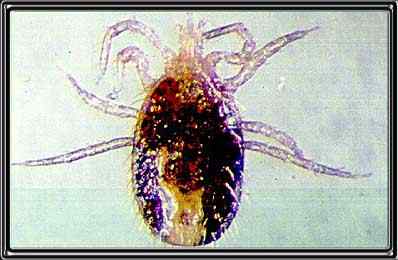
Ornithonyssus
bursa
(Bird Mite)
"Bird mites" or "Tropical fowl mites" are the common names used to describe the mite Ornithonyssus bursa from the family of mites Macronyssidae; these mites are often incorrectly called ‘bird lice’, particularly within the pest control industry, and are also commonly the cause of ‘paper mite’ problems (strictly speaking there are no such things as ‘paper mites’). This species of bird mite is widely distributed throughout warmer regions of the world. The mites are haematophagous (feed on blood) natural parasites of common birds including pigeons, starlings, sparrows, Indian mynahs, poultry, and some wild birds. Ornithonyssus bursa mites are small with eight legs, barely visible to the eye, oval in shape with a sparse covering of short hairs, and are extremely mobile. They are semitransparent in colour which makes them difficult to detect on skin until blood is ingested and then digested - when they may appear reddish to blackish.Contact with humans occurs after the birds gain entry through unprotected eaves, or to roof cavities via broken tiles to construct their nests in homes, factories, barns and other dwellings in early spring or summer. The large amounts of nesting material used by the birds provide the mites with an ideal environment in which to thrive. The unfeathered nestlings plus the adult birds occupying the nest are utilised as a ready blood source for the expanding population of mites. When the young birds are ready to fledge, some mites remain attached to the feathers of their bird hosts and feed intermittently. The mites remaining in the abandoned nest, and left without a suitable host when the birds leave or die, will roam and disperse throughout the dwelling over a 1-2 week period searching for new hosts. Most mites will die within 10 days without a blood meal from a bird host. They will bite but cannot survive on humans and do not infect/infest human skin.
Bites from these mites are difficult to diagnose and can be sometimes mistaken for flea bites although they are typically smaller and less florid. Although the effect of a bird mite invasion is temporary, the mites can cause severe irritation, rashes and intense itching from the saliva they inject while biting, and scratching of the bites may lead to secondary infections. Also, the sensation of crawling mites on the skin will irritate some people.
Bird mites do not live underneath the skin and are not associated with any diseases. The mites will bite at random and there are no selected areas of the body that are favoured, but clothed areas of the torso, limbs and the head area are commonly involved. A great deal of discomfort is experienced by the occupants of the building until the infestation is controlled or dies. A bird mite infestation cannot be maintained on humans but will persist while the bird-related source of the mites is maintained.
Treatment and Control
The irritation associated with bites can be alleviated with an anti-pruritic but there is no specific treatment. Severe reactions may have to be treated as for other allergic conditions with antihistamines.
Once the mite has been correctly identified, appropriate steps must be taken to remove the source of the infestation and prevent its recurrence. All nesting sites should be located, and the nesting material removed and the area cleaned to prevent other birds or inhabitants utilising the nest.
An insecticidal spray can be applied to ensure total eradication of mites, but spraying of rooms without removal of nests in roof cavities will not stop further mites entering and the problem will continue. Broken tiles or timber allowing access to roof cavities should be repaired, and all potential entry points to the eaves and roof cavity blocked. Roosting and nesting sites on window ledges should be cleared and made unsuitable for future bird use, if possible. A pest control officer may have to be employed to undertake these control measures, especially if large areas are involved.
Back to top of page
Back to main Parasite page
